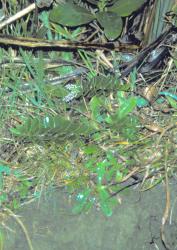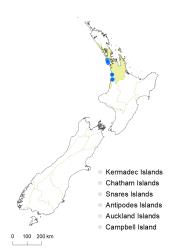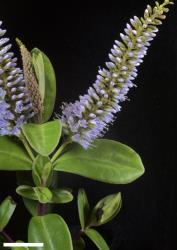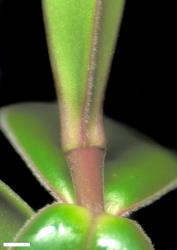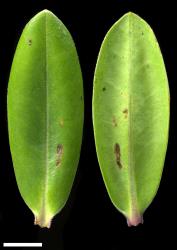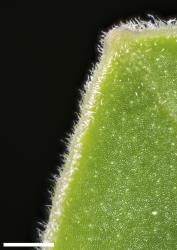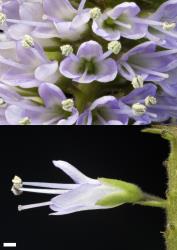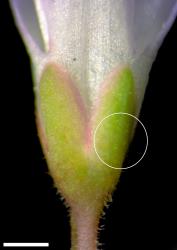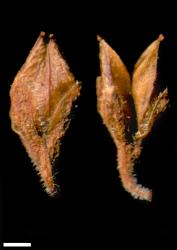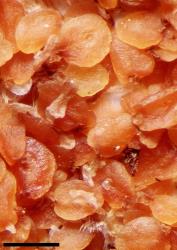- ≡ Veronica macroura var. dubia Cheeseman, Man. New Zealand Fl. 501 (1906)
- ≡ Hebe obtusata (Cheeseman) Cockayne & Allan, Trans. New Zealand Inst. 57: 15 (1926)
Spreading low shrub to 0.5 m tall. Stems prostrate to decumbent, eglandular-puberulent; hairs uniform to bifarious. Leaf bud distinct, its leaves appressed at margins until fully grown; sinus absent. Leaves opposite-decussate to sub-distichous, erecto-patent to spreading; lamina coriaceous, usually obovate, sometimes elliptic or oblong to sub-orbicular, 13–55 mm long, 7.0–28.5 mm wide, glossy green to dark green above, dull pale green to green beneath; midrib evident; surfaces usually hairy along midrib, sometimes glabrous above, sometimes minutely glandular-hairy beneath when young; margin ciliate, entire; apex obtuse to rounded or rarely retuse, slightly and bluntly plicate-acuminate; base cuneate; petiole 0.5–1.5 mm long. Inflorescence a lateral raceme, 38–126 mm long; flowers crowded, 34–88, all bisexual; bracts alternate or loosely whorled, lanceolate to narrowly oblong, < to > pedicels; pedicels spreading, sometimes recurved at fruiting, 1.0–3.3 mm long, shortly eglandular-hairy all around. Calyx lobes 4, bluntly obtuse to acute, 1.5–2.2 mm long, equal, eglandular-ciliate, usually with a few shorter glandular cilia, sometimes sparsely eglandular-hairy on outer surfaces. Corolla 5–6 mm diameter; tube white, 2.3–4.0 mm long, ≥ calyx, eglandular-hairy inside and sometimes outside; lobes 4, pale purplish or rarely white, erect or erecto-patent, sub-equal, lanceolate, elliptic, or ovate, 2.3–3.8 mm long, sub-acute to obtuse; nectar guides absent. Stamen filaments white or pale purplish, 4.7–7.5 mm long; anthers purplish or buff. Style glabrous, or rarely with a few eglandular hairs, 5–7 mm long. Capsules latiseptate, acute to sub-acute, glabrous, 3.7–4.5 mm long, 2.0–2.3 mm at widest point. Seeds discoid to elliptic, flattened, smooth, straw-yellow to pale brown, 0.9–1.3 mm long.
V. obtusata plants have a distinctive low-spreading habit and broad, dark green leaves that are often red on the margins. The small flowers are densely presented on the inflorescences and the corolla is pale purplish. In their leaf shape with red margins they somewhat resemble plants of V. speciosa, but flowers of that species are large, robust, and magenta.
Plants of V. obtusata and V. bishopiana grow together in places, and the two are quite similar, especially in the red pigmentation of young stems and leaves. Plants of V. bishopiana may be distinguished from V. obtusata by their shorter leaf margin hairs, narrower and thinner leaves that taper to an acute or acuminate apex, and are usually distinctively red beneath (especially when young), calyx lobes narrower and hairier on the outside, corolla lobes narrow and more rounded at the apex, capsule and style sometimes hairy, and smaller seeds.
North Island: Auckland (west coast from Muriwai to Kawhia).
Coastal and semi-coastal slopes, cliffs, and rock outcrops. Recorded elevations range from 0 to 360 m.
Flowers: mostly January–August but may flower as early as November; fruits: mostly January–September, but may fruit as early as November.
2n = 40 (see Bayly & Kellow 2006, as Hebe obtusata).
Veronica obtusata is classified in V. subg. Pseudoveronica sect. Hebe and the informal group “Occlusae” (Albach & Meudt 2010; Bayly & Kellow 2006).



